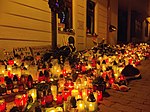Chatam Sofer Memorial

Chatam Sofer Memorial, formerly the Old Jewish Cemetery is the burial place and memorial of Moses Sofer, a prominent orthodox rabbi from the 19th century, built on the site of a 17th-century Jewish cemetery in Bratislava, Slovakia. The historical cemetery was mostly destroyed with the construction of the road tunnel under Bratislava Castle in 1943 but negotiations with the clero-fascist Slovak leader Jozef Tiso allowed an important fraction of the cemetery containing the graves of the rabbis to be preserved encased in concrete. Later, when the tunnel was converted for public transport trams a tram stop was constructed above the site. In 2002 a modern memorial was erected above the site and it was partially opened to the public.
Excerpt from the Wikipedia article Chatam Sofer Memorial (License: CC BY-SA 3.0, Authors, Images).Chatam Sofer Memorial
Nábrežie arm. gen. Ludvíka Svobodu, Bratislava Bratislava (District of Bratislava I)
Geographical coordinates (GPS) Address Nearby Places Show on map
Geographical coordinates (GPS)
| Latitude | Longitude |
|---|---|
| N 48.1418 ° | E 17.0918 ° |
Address
Nábrežie arm. gen. Ludvíka Svobodu
811 02 Bratislava, Bratislava (District of Bratislava I)
Region of Bratislava, Slovakia
Open on Google Maps











